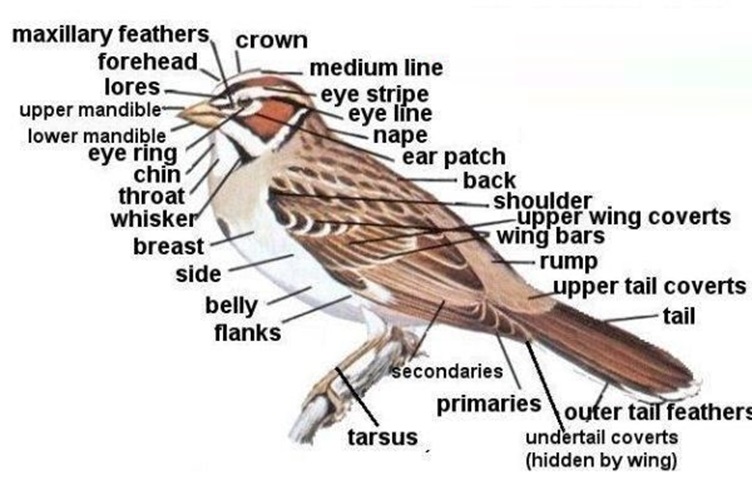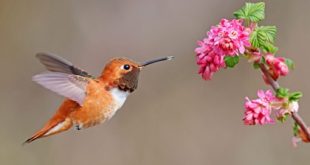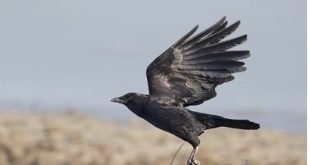Sparrows are small, agile, and fascinating birds that belong to the family Passeridae. These birds are widely distributed across the globe and have adapted to various habitats, including urban areas. Despite their small size, sparrows possess a well-adapted anatomy that allows them to thrive in different environments. This article provides a detailed exploration of the body parts of a sparrow and their respective functions, shedding light on how these birds navigate their lives.
A Body Parts Of Sparrow

1. Head
The head of a sparrow houses several essential organs that play vital roles in their survival:
a. Beak
The beak, or bill, is one of the most distinctive features of a sparrow. It is small, conical, and sturdy, perfectly adapted for cracking seeds, which form the bulk of their diet. In addition to feeding, the beak is used for grooming, nest building, and defending territory.
b. Eyes
Sparrows have sharp eyesight, essential for detecting predators and locating food. Their eyes are positioned on the sides of their head, providing a wide field of vision. Sparrows also possess a third eyelid, called the nictitating membrane, which helps keep their eyes clean and protected.
c. Nostrils
Located at the base of the beak, the nostrils allow sparrows to breathe and detect smells. Although sparrows rely more on their sight and hearing, their sense of smell aids in recognizing environmental cues and food sources.
d. Ears
Sparrows have small, inconspicuous ear openings located behind their eyes, covered by feathers. Their keen sense of hearing helps them communicate with other sparrows and detect potential threats.
2. Neck
The neck of a sparrow is flexible and muscular, allowing them to move their head in various directions. This mobility is crucial for scanning their surroundings, grooming, and feeding. The neck also supports the bird’s head, which is proportionally large compared to its body size.
3. Body
The body of a sparrow is compact and streamlined, designed for efficient movement and flight. Key components of the body include:
a. Wings
Sparrow wings are short and rounded, enabling quick and agile flight. The wings consist of three primary parts:
- Primaries: The outermost feathers that provide thrust during flight.
- Secondaries: Feathers closer to the body that aid in lift and gliding.
- Coverts: Small feathers that cover the base of the primaries and secondaries, streamlining the wing.
Sparrows use their wings for more than just flying; they also perform courtship displays and defend their territory.
b. Feathers
Feathers are essential for insulation, camouflage, and flight. Sparrows have a brown and gray plumage that helps them blend into their surroundings, protecting them from predators. Feathers also play a role in communication during mating rituals.
c. Chest (Breast)
The chest houses powerful flight muscles, particularly the pectoral muscles, which account for about 15-25% of a sparrow’s body weight. These muscles provide the strength required for sustained flight.
d. Back and Tail
The back supports the wings, while the tail aids in balance and steering during flight. Sparrows have a fan-shaped tail made up of long feathers called rectrices. By adjusting their tail position, they can change direction mid-air and maintain stability.
4. Legs and Feet
Sparrows have strong, slender legs and feet adapted for perching and hopping. Their legs are covered in scales, providing protection and support. The key features include:
a. Toes and Claws
Sparrows have three forward-facing toes and one backward-facing toe, a configuration known as anisodactyl. This arrangement allows them to grip branches securely. The sharp claws provide additional stability and help sparrows scratch the ground for food.
b. Hindlimbs
The hindlimbs are muscular and enable sparrows to jump and hop efficiently. While sparrows are not ground-dwelling birds, their legs allow them to forage on the ground for seeds and insects.
5. Internal Organs
Sparrows’ internal organs are specialized for their diet and active lifestyle. Some key internal components include:
a. Heart
The sparrow’s heart is relatively large for its size, ensuring efficient circulation of oxygen-rich blood. A high metabolic rate supports their energetic activities, such as flying and foraging.
b. Lungs and Air Sacs
Sparrows have a highly efficient respiratory system comprising lungs and air sacs. This system allows a continuous flow of oxygen, critical for sustaining their energy-intensive flight.
c. Crop and Gizzard
The crop is a pouch in the esophagus that stores food temporarily, allowing sparrows to eat quickly and digest later. The gizzard, a muscular part of the stomach, grinds the food with the help of ingested grit, breaking down tough seeds.
d. Digestive System
Sparrows have a short and efficient digestive tract designed for rapid processing of seeds and insects. Their diet provides the necessary energy and nutrients for their active lives.
6. Reproductive System
During the breeding season, the reproductive organs of sparrows become more prominent. Female sparrows have ovaries that produce eggs, while males have testes that produce sperm. Both sexes play roles in nest building and raising chicks.
7. Skin and Preen Gland
Sparrows have a thin layer of skin beneath their feathers. The preen gland, located at the base of their tail, secretes an oily substance that sparrows use to maintain their feathers. Preening helps waterproof their plumage and keeps it flexible and clean.
8. Bone Structure
Sparrows have lightweight, hollow bones that reduce their body weight without compromising strength. This adaptation is crucial for flight. Their skeletal structure includes a keel-shaped sternum, where the powerful flight muscles attach.
Conclusion
The anatomy of a sparrow is a marvel of natural engineering, perfectly adapted for their lifestyle. From their sharp eyes and versatile beak to their powerful wings and efficient digestive system, every body part serves a specific purpose. Understanding these features not only deepens our appreciation for sparrows but also highlights the intricate adaptations that enable them to thrive in diverse environments. These small birds may seem ordinary at first glance, but their anatomy reveals a complex and fascinating story of survival and success.


